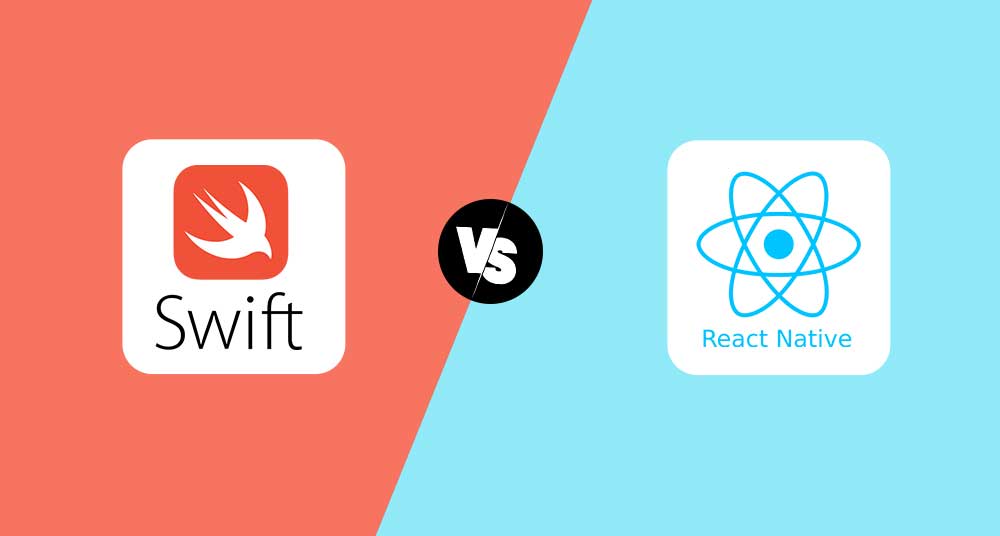What is React Native?
Only one operating system at a time is the focus while creating native apps. Only one operating system at a time is the focus while creating native apps. Consider
the JavaScript framework React Native, a potent yet user-friendly tool for creating online applications.
The language is quite simple to learn, and since the first language launch in 1995, several new tools have been made accessible. It would help if you coded for Android and iOS platforms simultaneously to produce two native applications.
What is Swift?
Swift is a multi-paradigm, all-purpose programming language. Apple and the open-source developer community created it at first. When this language was introduced in 2014, Objective-C, Apple’s previous programming language, was mostly intended to be replaced.
Since Objective-legacy C’s has been eliminated by the language, writing code is now incredibly simple and has almost no disadvantages. The simplest method for developing an iOS app is this. It is a basic language for various operating systems, including iOS, macOS, tvOS, watchOS, and others. IOS app development companies mostly prefer Swift.
The benefits and drawbacks of utilizing React Native
Yes, Before choosing between responding native and quickly, it is important to weigh the advantages and disadvantages of each technology. Let’s see the advantages and disadvantages of React Native below:
Advantages of React Native
The user experience offered by native apps may be remarkable. High performance is often what they provide. The aesthetics are adjusted to the platform’s UX design, enhancing the UX.
Flawless execution and quickness
Because they were created specifically for an operating system, native applications make the most of the device’s processing power. The apps operate smoothly and with respectable performance.
Offline tasks
Native apps can function even when there is no Internet connection. If you need the necessary capabilities to construct a native application, a strong Internet connection is necessary.
Outstanding UI/UX Design skills
Excellent design options are offered, as well as a great user experience. Developers might, for instance, employ the most cutting-edge UI/UX designs and animation.
Easily navigable
Apps offer straightforward user interfaces that make it easy for users to become familiar with the software.
Simple equipment integration
Integrating native apps with a device’s touchscreen, GPS, and the camera is simple.
Effortless application launch
Apps are easier to launch on the App Store since they precisely adhere to operating system rules.
Greater safety and dependability
Native apps are safe and dependable since they adhere to all operating system rules and are examined and authorized by the App Store. They guaranteed quick deployment of top-notch features. Complex features like VR, AI, IoT, and AR may be swiftly and seamlessly implemented into native apps.
Newest SDKs and developer tools
Developers can access frequently updated libraries and solutions that connect with a particular OS. The React Native libraries enable the development of apps for both platforms.
Cross-platform programming
Cross-platform programming delivers significant time and financial cost savings. The key point is that building cross-platform app components that deliver excellent performance comparable to native ones is challenging.
The following is a list of the main benefits of cross-platform programming.
Reusable software
With cross-platform mobile application development, programmers can simultaneously use the same code across many operating systems and applications. Making modifications and maintaining the code’s functionality are made simple using a single code.
More rapid time to market
Hybrid mobile apps always reach the market more quickly and are goods that are ready for launch. Application developers can swiftly release applications by using this kind of framework.
Decreased development expenses
Costs can be greatly decreased for developers by utilizing a cross-platform framework. Because it takes less time and effort to develop an application, the cost of doing so is reduced.
Close to native app performance and user experience
Mashups have comparable traits and internal workings. This enables developers to expedite the process while maintaining a consistent user experience. There are testing and refinement phases when using a cross-platform framework, but in the end, you will have an easily adaptable application to the preferred platform.
Disadvantages of React Native
However, a minor flaw will cause major problems for projects with limited funding. For instance, native apps will be extremely expensive for a startup. Less expensive than reactive jets but still comparable to shouldering the expenditure.
React Native is the ideal option if your application does not need to do so much work. The best option is to use native development if your program requires a lot of labor. React Native, however, is insufficient if you need a foundation for a large app.
Top React Native applications:
- Facebook, Walmart and Bloomberg
- The smallest list of React Native-written apps includes Instagram, Skype, Walmart, Tesla, Facebook, and Wix.
Swift’s benefits and disadvantages
Benefits of utilizing Swift
With Swift, you can create a product that can match future demands and, as necessary, add entirely new features to it. Swift apps scale more easily in general. Swift offers superior speed than React Native, despite the possibility of higher CPU usage when executing an application.
Due to their compatibility, Objective-C and Swift can be used in the same project. This is particularly helpful for significant renovation or expansion projects. By utilizing the Objective-C codebase, developers can use Swift to add new features. This facilitates a secure and simple transmission process.
Thanks to Apple’s sponsorship, Swift has one of the most vibrant and engaged open source communities. Despite being a new language, developers already have access to many resources. Swift enables code reuse and sharing, lowering development costs and expediting the development process for front-end and back-end applications.
Cons of utilizing Swift
The product’s occasional quality loss is the only negative of Swift mobile development. Swift is still a young language and sometimes lacks the necessary talent to support the entire tech stack.
Swift applications that are in demand: LinkedIn, Slack and WhatsApp
Swift vs React Native: Comparison
React Native is the greatest choice for cross-platform development, while Swift is best for developing iOS apps. For example, you could use Java or Kotlin to create an Android app while sticking with Swift and Objective-C for iOS-only development.
Speed of Development
Swift development is faster than React Native, in this case, if you’re making native iOS apps. While React Native is based on a JavaScript framework that is a potent yet user-friendly tool for building online applications, Swift will be the simplest approach to creating an iOS app.
Programming Language
React Native may use JavaScript to create cross-platform applications. Today’s web community uses a language called JavaScript a lot. In conjunction with React and other well-known JavaScript frameworks, this language is often utilized. Swift was created as a language to replace Objective-C, the previous programming language used by Apple.
User Experience
Application components resemble native ones in appearance. React Native employs native components, so developers can be assured that their applications’ components will update immediately in response to any OS UI upgrade.
Swift does a terrific job integrating into iOS design and utilizing UX concepts as the native iOS language created by Apple for designing apps. But creating an app with Swift is like starting from scratch when creating a native app. As a result, each component needs to be designed specifically for it and polished to perfection.
Performance
The performance of Swift in comparison to React Native is something else to consider. A Swift app will typically perform better than a framework. Swift has a higher performance than React Native, despite the fact that executing an application on it can use more CPU resources.
Using the React Native framework while working with graphic effects might be challenging. React Native offers developers the option of using custom code within the application and a variety of resources and tools to address various issues.
Learning a language
Due to JavaScript, which has been around for many years, React Native is quite simple to learn. Therefore, the language is well-known among developers. Swift is a simple language to learn. Apple built it knowing that users would have to learn it from scratch. Rare specialists who are still interested in it exist, nonetheless.
Team for development
Remember that finding a iOS app development business won’t be simple. It’s simpler to locate React Native engineers for hire. React Native projects are more likely to attract experienced developers than Swift ones because Swift is the latter’s more recent and still-evolving language, and the talent are more scarce.
Swift vs React Native: Which is better for iOS app development?
The React Native framework and JavaScript, according to developers, are simpler to learn than Swift. Learning how to construct cross-platform applications for mobile devices won’t be challenging if the team already writes online applications in React.
React Native is the only programming language that will let you create an application for two platforms with a single team. Working with a cross-platform framework can save you money because you won’t have to hire extremely expensive native engineers who speak two languages.
Anyway, React Native and Swift are both potent tools for creating apps. You should choose according to your needs. The best option is React Native if you want to:
Choose React Native if, with few resources and a small team, it is necessary to create an application for the iOS as well as Android platforms; Both iOS and Android versions of your program must display and function identically; Faster application development is required, along with live or hot reloading.
Choose Swift if:
· It is important to create an iOS-only application;
· The application needs to be kept up for a while.
· You must create a complicated program that primarily utilizes platform-specific code;
· To handle things like memory usage, a program is necessary.
So, before making a decision, consider the project’s requirements.
iOS App Development Tools
Xcode
Swift applications can be made for iOS devices using Xcode, a tool that Apple has released. Making apps for the Mac, iPad, iPhone, Apple Watch, and Apple TV is the first choice for novice developers.
Transporter
You can easily upload your files to Apple with the help of the Transporter tool. Being a developer makes it simple for you to distribute books, music, TV episodes, movies, and apps across all Apple platforms.
AppCode
JetBrains introduced AppCode, a sophisticated tool created on the IntelliJ IDEA platform. It employs plug-ins to expand its capabilities, or you may write your plug-ins to expand it.
Conclusion:
Swift and React Native are both great frameworks for building mobile applications. However, one may be selected over the other depending on the needs of the project.
Swift is more appropriate in the following situations:
- An iOS-only app development project.
- It is considering future app maintenance, a project for an app that calls for a lot of platform-specific code.
- Applications for certain tasks, including controlling memory footprints.
React Native, for instance, is favored in the following circumstances:
- For the development of an app for Android and iOS, you have a small team and a constrained budget.
- An application that needs to look the same across all platforms.
- To speed up development, one must use the hot reloading capability.
- Your project’s requirements must be considered when choosing the ideal development platform for your project.






What do you think?
It is nice to know your opinion. Leave a comment.